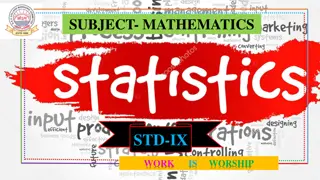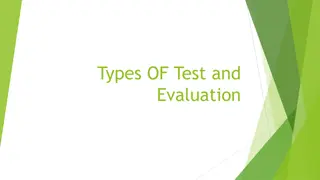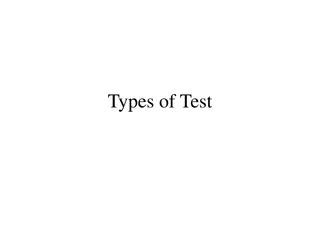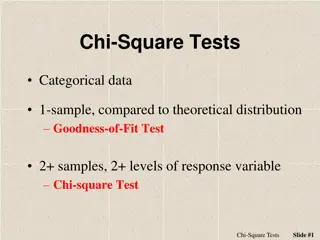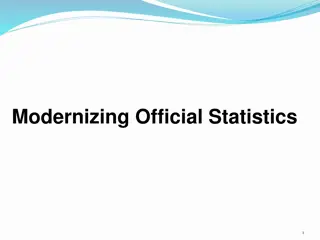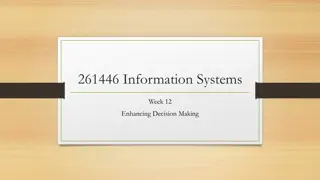Understanding Significance Tests and Decision Making in Statistics
Learn how to determine the statistical significance of study results and make appropriate conclusions using significance levels. Explore the concepts of Type I and Type II errors, significance levels, and decision-making processes in statistical analysis. Understand the significance of P-values and how they influence the acceptance or rejection of null hypotheses. Enhance your understanding of statistical interpretation and decision-making in research and analysis.
Download Presentation

Please find below an Image/Link to download the presentation.
The content on the website is provided AS IS for your information and personal use only. It may not be sold, licensed, or shared on other websites without obtaining consent from the author. Download presentation by click this link. If you encounter any issues during the download, it is possible that the publisher has removed the file from their server.
E N D
Presentation Transcript
Testing a Claim Lesson 8.2 Significance Tests and Decision Making Statistics and Probability with Applications, 3rdEdition Starnes & Tabor Starnes & Tabor Statistics and Probability with Applications, 3rd Edition Bedford Freeman Worth Publishers Bedford Freeman Worth Publishers
Significance Tests and Decision Making Learning Targets After this lesson, you should be able to: After this lesson, you should be able to: Learning Targets Determine if the results of a study are statistically significant and make an appropriate conclusion using a significance level. Interpret a Type I error and a Type II error in context. Give a consequence of a Type I error and a Type II error in a given setting. Statistics and Probability with Applications, 3rd Edition 2 2
Significance Tests and Decision Making There are two types of conclusions you can make in a significance test: P-value small Reject H0 Convincing evidence for Ha (in context) P-value large Fail to reject H0 Not convincing evidence for Ha (in context) To determine if a P-value should be considered small, we compare it to a boundary value called the significance level. We denote it by , the Greek letter alpha. Significance Level The significance level is the value that we use as a cutoff to decide if an observed result is unlikely to happen by chance alone when the null hypothesis is true. Statistics and Probability with Applications, 3rd Edition 3 3
Significance Tests and Decision Making When our P-value is less than the chosen significance level in a significance test, we say that the result is statistically significant at the = ___ level. In that case, we reject the null hypothesis H0 and conclude that there is convincing evidence in favor of the alternative hypothesis Ha. How to Make a Conclusion in a Significance Test If P-value < : Reject H0 and conclude that there is convincing evidence for H a (in context). If P-value : Fail to reject H0 and conclude that there is not convincing evidence for H a (in context). Statistics and Probability with Applications, 3rd Edition 4 4
Significance Tests and Decision Making When we draw a conclusion from a significance test, we hope our conclusion will be correct. But sometimes it will be wrong. There are two types of errors we can make: a Type I error or a Type II error. Type I Error, Type II Error A Type I error occurs if a test rejects H0 when H0 is true. That is, the test finds convincing evidence that H a is true when it really isn t. A Type II error occurs if a test fails to reject H0 when H a is true. That is, the test does not find convincing evidence that H a is true when it really is. Statistics and Probability with Applications, 3rd Edition 5 5
Significance Tests and Decision Making Truth about the population H0 true Truth about the population H a true Conclusion based on sample Reject H0 Type I error Correct conclusion Conclusion based on sample Fail to reject H0 Correct conclusion Type II error If H0 is true: Our conclusion is correct if we don t find convincing evidence that H a is true. We make a Type I error if we find convincing evidence that H a is true. If H a is true: Our conclusion is correct if we find convincing evidence that H a is true. We make a Type II error if we do not find convincing evidence that H a is true. Statistics and Probability with Applications, 3rd Edition 6 6
Significance Tests and Decision Making The most common significance levels are = 0.05, = 0.01, and = 0.10. Which is the best choice for a given significance test? That depends on whether a Type I error or a Type II error is more serious. Determining Type I Error Probability The probability of making a Type I error in a statistical test is equal to the significance level . Statistics and Probability with Applications, 3rd Edition 7 7
LESSON APP 8.2 Are these potatoes keepers? A company that makes potato chips requires each shipment of potatoes to meet certain quality standards. If the company finds convincing evidence that more than 8% of the potatoes in the shipment have blemishes, the truck will be sent back to the supplier to get another load of potatoes. Otherwise, the entire truckload will be used to make potato chips. The producer will perform a significance test using the hypotheses H0 : p =0.08 Ha : p > 0.08 where is the true proportion of potatoes with blemishes in a given truckload. Statistics and Probability with Applications, 3rd Edition 8 8
LESSON APP 8.2 Are these potatoes keepers? A supervisor selects a random sample of 500 potatoes from the truck and finds that 52 of the potatoes ( = 0.104) have blemishes. The resulting P-value of the test is 0.0240. What conclusion should the supervisor make at = 0.05? Describe a Type I and a Type II error in context. Give a consequence of each type of error in this setting. Which error is more serious for the potato chip producer? Explain. Based on your answer to Question 3, do you agree with the producer s choice of = 0.05? Why or why not? 1. 2. 3. 4. Statistics and Probability with Applications, 3rd Edition 9 9
Significance Tests and Decision Making Learning Targets After this lesson, you should be able to: After this lesson, you should be able to: Learning Targets Seatwork/Homework: Determine if the results of a study are statistically significant and make an appropriate conclusion using a significance level. Interpret a Type I error and a Type II error in context. Give a consequence of a Type I error and a Type II error in a given setting. Lesson 8.2 Seatwork/Homework Pg. 512 #1, 2, 5, 8, 9, & 12 Statistics and Probability with Applications, 3rd Edition 10 10





